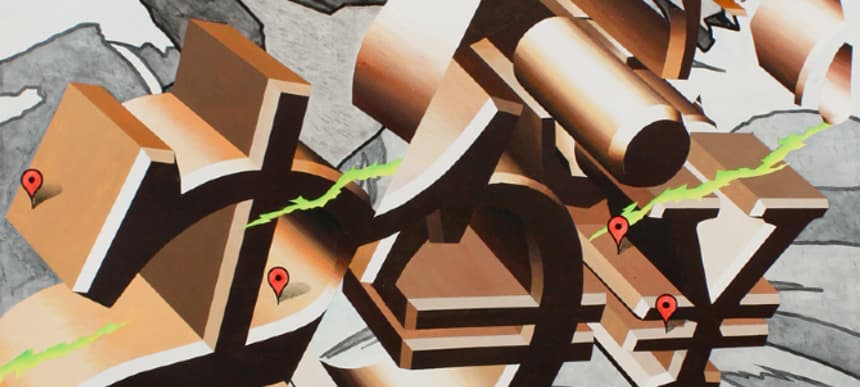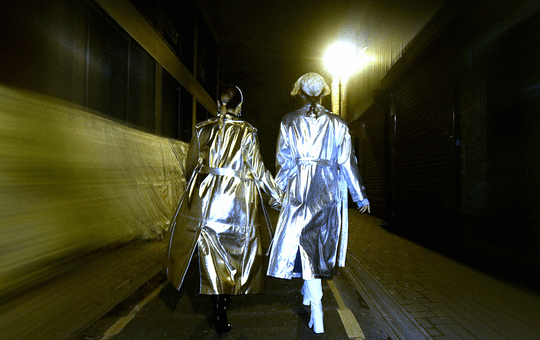
The Art Of Noise: Air Max '97
Click the any image above to launch the photo gallery.
Whilst best known as a producer and DJ on forward-thinking electronic labels such as London’s Trax Couture and Liminal Sounds, Air Max ’97, aka Oliver van der Lugt is also a prolific art director and sculptural artist in Melbourne.
Recently launching his record label ‘DECISIONS’ to take his musical output into his own hands from the A&R to the visuals, he designed the branding, logo and website himself. For the first vinyl release of his own tracks Core Work/Expenditure, he commissioned Timothy Erdei, a Hungarian robotics professor on an image of a complex 3D fractal for the cover artwork. Along similar lines, the music video also features a 3D fractal fly-through created by Mat Col, another fractal enthusiast from Germany. “I stumbled upon their work around the time I was conceptualising the release and felt it was a great fit,” van der Lugt explains. “I like using material from visual tropes that already exist (there’s a whole world of 3D fractal artwork floating around online). It's similar to my approach of using readymade materials elsewhere in my art practice.”
The artwork is clearly a big part of his creative vision and identity, considering each release with a level of flexibility rather than following anything strictly thematic. “I thought very carefully about whether I wanted to make a more serialised artwork format à la Fade To Mind/Night Slugs or Sound Pellegrino, but instead decided that the artwork for each release will be approached afresh.”
Besides art direction for his musical endeavours, van der Lugt has been a regular collaborator with Paris-based fashion label ASSK, developing prints and graphics, and is also currently working on a small collection with a Japanese brand. Whilst he worked solo on designs such as a t-shirt for Liminal Sounds, he also collaborates with a creative partner, Jona De Mallory aka Rap Simons on the branding for their previous Melbourne club night and collective, Club ESC with DJ Aspartame. “We also made a t-shirt design for Nguzunguzu that was produced by the Japanese brand Revolver…collaboration is a struggle because I'm a control freak, but it's also a really valuable process. We'd start with conversations and then tag team on certain poster or garment designs and build things in waves of input from each other. Or sometimes delegate different aspects to one another and put them together at the end.”
Under his own name Oliver van der Lugt, he has also exhibited as an artist, often working with sculptures, re-purposing consumer products, especially (not surprisingly) with sporting goods, to plastic bottles, and mass-produced household objects. “I'm very interested in deploying readymade and consumer items and materials,” he explains. “Every object and material comes with its own set of cultural information and connotations, aesthetic and vibe. I like the chemistry you can build between things, and the way they reveal qualities in one another that they might not by themselves. Objects say a lot about humans. Certainly there is an environmental concern, even if this is simply gesturing towards how deeply implicated we all are in capitalism. Water features a lot in my art practice; I love its elementality and metaphysical aura, and at the same time it is a fundamental human resource becoming increasingly scarce while undergoing rapid privatisation and commodification.”
His recent sculpture, exhibited as part of his show ‘spec’ at Utopian Slumps in Melbourne, was an octagonal ‘wishing well’ constructed from concrete besser blocks, builder's plastic, and iridescent perspex. The ‘well’ was filled with water, a handful of loose coins, crystal ball paperweights, and an unscratched lottery scratch card – whilst a pair of Flyknit Air Maxes floated on the surface of the water. “I liked that their giant air soles allowed them to mystically walk on water.” van der Lugt says. “I was exploring the elusive, affective and qualitative dimension of economic systems. As in, every economic system of exchange that we think of in terms of data actually has a unquantifiable cloud of faith, desire, confidence, speculation, anxiety and aspiration suffusing it. Fiat currency is a perfect illustration of this: our paper or plastic banknotes and amalgam coins are only worth their stated amounts, because we as societies collectively agree to recognise them as having that value. This is a totally amazing and crazy mass-scale system of faith and confidence. Value is actually always a slippery concept. To me, the wishing well embodies a threshold between these dimensions, where people exchange money for a wish (which many viewers of the sculpture did). The shoes extend this exploration into the world of consumer objects. I'm fascinated by the vast space of value and desire generated between brands and their consumers around what are ultimately 'functional' sporting goods.”
It’s clear that certain themes run through his work across art, fashion and music, from the structural use of his materials reinterpreting everyday symbolism. “I think a big [theme] is the concept of the profane.” he says. “There is a wonderful text by Giorgio Agamben that inverts the normal dichotomy between the sacred and the profane, arguing that the profane, defined as that which is earthly, corporeal, and common to us all here on earth (as opposed to the sacred, up beyond our reach in the heavens), is that which is truly magical and beautiful. I love that.” He continues: “I think in my art practice I’ve always been an advocate of the profane and I had a nice revelatory moment realising that dance floors and the world of fashion are amazingly profane spaces, arguably much more so than art galleries.”
“I think in my art practice I’ve always been an advocate of the profane and I had a nice revelatory moment realising that dance floors and the world of fashion are amazingly profane spaces, arguably much more so than art galleries.” – Air Max '97
The presence and influence of the Internet is also evident in his glossy, hyperreal world of global logos and modern synthetics. “I think our highly networked reality has a paradoxical effect where there is radical access to everything, which articulates difference, but there is still a very strong normalising logic.” However the danger of focusing on the online is homogenising cultures and opinions, he suggests: “Trends are fun but come with the very real danger of commodifying and stripping specific localised cultures of their content, and then moving onto the next one. Real conversations are hard to have both online and offline, and it’s important to make spaces for them to happen.”
The separation between such diverse fields whether mentally or publicly for him definitely exists, but occasional overlap is inevitable and offers creative benefits. “I have always looked at it that way, because I acknowledge that each context has its own specific way of working that I want to take into account and engage with.” he says. “But there are definitely themes that bleed through the different practices, and I'm cool with people knowing about the different things I do. It's more and more common I think for 'creatives' to simultaneously work in multiple lanes, but our systems for presenting and appraising cultural production hasn't yet caught up. Kanye is always my favourite example of this—the amount of flack he cops for quite radically crossing boundaries between different cultural spaces reveals how entrenched that partitioning attitude is. Love Kanye.”
'Core Work' is available digitally via DECISIONS, with vinyl following on October 23rd (buy).













